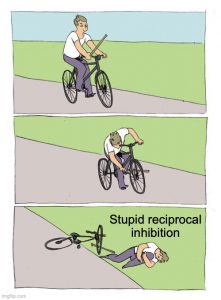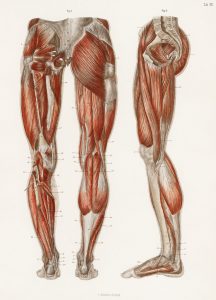Does Reciprocal Inhibition Actually Happen?
Reciprocal Inhibition is a term used in the fitness and rehab world for a few decades, if not the past century, and essentially means when you contract a muscle, the antagonist (or muscle that would work in opposition of the one you’re contracting) would shut down. Think of your biceps curling all the weight and the triceps going limp.
There’s a bunch of evidence that this happens in lab settings. Most likely it’s through a 1a alpha neuron inhibitory pathway between agonist and antagonist muscles, and this pre-synaptic inhibition decreases contractile tone in the antagonistic muscle enough to be relevant in a lot of clinical and pathological settings.
From an applied perspective, it makes sense to reduce the antagonistic action that would resist the agonistic action. It would be like putting the e brake on with your car when you drive, it would just be added resistance to have the antagonistic muscle contract and resist the agonist further.
That being said, it doesn’t make sense that it would always shut off the antagonist, especially as muscle contractions happen across a wide range of intensities and conditions.
If I contract a muscle at 10% of my max intensity, things are generally very different than when I contract at 100% intensity, respective to other muscles contracting, vascular dynamics, core bracing requirements, and whether I’m enjoying my life or hating everything about everything.
Hirabayashi et al found that at 5-15% max contraction intensity, reciprocal inhibition did occur on the inhibitory alpha neuron, but didn’t as the relative intensity got up above 30%. This was also backed up by Shindo et al who found max intensity for reciprocal inhibition was around 15%. After that there was a shift towards different involvement, specifically to the gamma pathway. While this is cool and all, it’s sort of like Danhausen, in that if you know what it is, you’re loving it and everything that I just said, but if not then there’s really no reason to get deeper into what it is.

Very nice, very evil.
Interestingly, Tanino et al found that at higher MVCs, (50% ish), there wasn’t a concurrent inhibition during contraction, but a notable reduction in H-reflex amplitude following fatiguing contraction of the ankle plantaflexors. This is essentially a post-contraction refractory period, decreasing post-activation neural inhibition to antagonists with slightly higher intensity. This could be a reason why my Planks for Hip Mobility concept could work.
What about higher impact or faster loading? When running or jumping, do we see similar inhibitions? Maybe. Van Boxtel showed with tendon jerk reflex action, loading the soleus rapidly reduced tibial nerve activity quickly but then quickly recovered for a post-activation potentiation. Essentially, when you load the calf rapidly to do a jump or run stride, the tibialis quickly decreases and then increases activity to match the inverse requirements of the calf. It would suck if you were running and pushed off with the calf, but then your tibialis anterior didn’t work to lift your toes up quickly and you wound up faceplanting after tripping over your own feet.

What about in different ranges of motion? There’s some evidence that when a sarcomere gets stretched enough (between 85-130% of normal sarcomeric length), it can kick up sympathetic activation and cause the muscle to try to contract, as shown by Welsh & Segal, but didn’t note any antagonistic measurements as they were primarily interested in blood flow and vascular dynamics from the stretch.
Outside of this, there’s not much research that’s been done to show reciprocal inhibition happens or doesn’t happen at certain ranges of motion, hoewever you could likely do your own field experiments and try to contract a muscle as far as possible and feel the antagonist to see what it does. If the antagonist isn’t at end range stretch where it would kick up the tendon stretch reflex and cause some sympathetic activity, it will likely shut down noticeably. If you’re really “tight” and getting to that end range in the agonist puts you past the threshold to trip that tendon response, you’ll likely find more of a co-cotraction throughout the sarcomeric length.
So while there’s not a lot of specific evidence linking reciprocal inhibition to a position of the muscle (either shortened or lengthened), it seems most likely to happen at the shortest agonistic position with relatively high MVC compared to other ranges under the same intensity. Cool.
In more complex movements, or under higher relative intensities, there doesn’t seem to be much evidence of reciprocal inhibition, specifically when seen in training scenarios.
Most of the time, you’re going to see contractions of all muscles around a working joint in order to balance distractive forces on it and keep it in place. If you raise your arm in the front with the effort of the biceps and deltoid, you’ll likely also see effort from the triceps and infraspinatus to allow the humerus to rotate in the glenoid and not slide out and up with the direction of pull. Same goes with the hamstring and quad in any leg dominant activity.

The collective contraction of the involved muscles leads to improved centration of the ball in the socket, and easier rotation without gumming up the works. This holds out even as you get into max efforts, and into end ranges with tension development.
So TL:DR, does reciprocal inhibition actually happen? Absolutely, but it’s not an all the time or for every scenario type of thing.
- Most reciprocal inhibition is for lower intensity contractions, OR can occur after higher intensity contractions.
- other inhibitory actions are paired cyclic reflexes with contractile cycles of the agonist, meaning when the agonist contracts and relaxes, the antagonist relaxes and contracts.
- For most fitness intensities and ranges of motion, it’s not a thing to consider or would present any interference in your workouts worth noting.
This is by no means an exhaustive look through the neurophysiology of contractile elements within reflexive stuff like reciprocal inhibition, but should hopefully provide some answers along the way. A with everything involving the body and response to exercise, the answer comes back to “it depends,” and I’m thinking I laid out a few of those conditional situations pretty well. And if not, well you can feel free to argue with me on the internet.